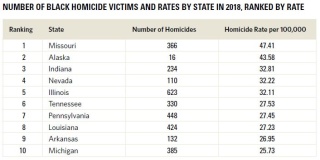Sally Martinelli
202-822-8200 x104
smartinelli@vpc.org
Missouri has the Highest Black Homicide Victimization Rate in the Nation for the Fifth Year in a Row
(Black PR Wire) Washington, DC — Guns are by far the most common weapon used to kill Black homicide victims in America, according to a new study by the Violence Policy Center (VPC). The study found that 86 percent of Black homicide victims nationwide were killed with guns. Of these, two thirds were killed with a handgun.
In addition to national data, the annual study, Black Homicide Victimization in the United States: An Analysis of 2018 Homicide Data, also ranks the states according to their Black homicide victimization rates. It is based on unpublished data from the Federal Bureau of Investigation (FBI) Supplementary Homicide Report (SHR). The study details homicide rates for 2018, the most recent year for which comprehensive national data is available. This is the 15th year the Violence Policy Center has released the study. To see past editions of the study, click here.
“In 2018, Black men, women, boys, and girls were only 14 percent of our nation’s population, yet accounted for 50 percent of all homicide victims. These deaths devastate families, traumatize communities, and almost always involve a gun. The goal of our research is to help support community advocates and organizations working on the ground to stop this lethal violence while, at the same time, continuing to educate and engage the public and policymakers on the need to address this ongoing national crisis,” states VPC Executive Director Josh Sugarmann.
For the entire UNITED STATES, the study finds that in 2018:
- There were 7,426 Black homicide victims in the United States that year. Blacks represented 14 percent of the U.S. population, yet accounted for 50 percent of all homicide victims.
- The Black homicide victimization rate in the United States was 18.18 per 100,000. In comparison, the overall national homicide victimization rate was 4.92 per 100,000. For whites, the national homicide victimization rate was 2.83 per 100,000.
- Of the 7,426 Black homicide victims, 6,314 were male, 1,111 were female, and the sex of one victim was unknown. The homicide victimization rate for Black male victims was 28.48 per 100,000. In comparison, the overall rate for male homicide victims was 7.17 per 100,000 and the rate for white male homicide victims was 3.76 per 100,000. The homicide victimization rate for Black female victims was 4.63 per 100,000. In comparison, the overall rate for female homicide victims was 1.93 per 100,000 and the rate for white female homicide victims was 1.48 per 100,000.
- For homicides in which the weapon used could be identified, 86 percent of Black victims (6,116 out of 7,072) were shot and killed with guns. Of these, 66 percent (4,024 victims) were killed with handguns.
- For homicides in which the victim to offender relationship could be identified, 76 percent of Black victims (2,267 out of 2,995) were killed by someone they knew. The number of victims killed by strangers was 728.
- For homicides in which the circumstances could be identified, 70 percent (3,018 out of 4,335) were not related to the commission of any other felony. Of these, 51 percent (1,531 homicides) involved arguments between the victim and the offender.
In addition, individuals living in communities where violence is prevalent are at higher risk for a broad range of negative health and behavior outcomes. An increased understanding of how trauma resulting from community violence influences development, health, and behavior can lead to improvements in the way many social services are delivered as well as policy changes at the local and federal levels (see the July 2017 VPC study The Relationship Between Community Violence and Trauma: How Violence Affects Learning, Health, and Behavior, https://vpc.org/studies/trauma17.pdf). At the same time, the firearms industry, looking to expand beyond its shrinking base of white male gun owners, has launched an organized marketing campaign focusing on Blacks and Latinos. If successful, such efforts can only increase gun death and injury in these communities (see the January 2021 Violence Policy Center study How the Firearms Industry and NRA Market Guns to Communities of Color, https://vpc.org/how-the-firearms-industry-and-nra-market-guns-to-communities-of-color/).
The FBI data includes incidents reported as justifiable homicides of Black victims killed by law enforcement. Nationwide, there were 110 such incidents reported in 2018. The data does not specifically identify killings by police that are not ruled justifiable. In December 2015, the FBI announced that it would dramatically expand its data collection on violent police encounters by 2017. In October 2016, the U.S. Department of Justice outlined a plan to improve the collection of law enforcement use of force data. The FBI has begun to release online very limited information on law enforcement use of force incidents. In addition, the agency notes that in 2020 only 5,030 out of 18,514 federal, state, local, and tribal law enforcement agencies throughout the nation participated and provided use of force data. The officers employed by these agencies represent 42 percent of federal, state, local, and tribal sworn officers in the nation.
The rate of Black homicide victimization is calculated by dividing the number of Black homicide victims by the Black population and multiplying the result by 100,000. This is the standard and accepted method of comparing fatal levels of gun violence.
The full study is available at http://vpc.org/studies/blackhomicide21.pdf.
***
The Violence Policy Center is a national educational organization working to stop gun death and injury. Follow the VPC on Twitter and Facebook.

